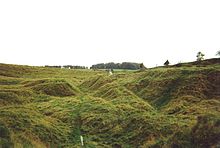Charterhouse, Somerset
| Charterhouse | |
|---|---|
Avon and Somerset | |
| Fire | Devon and Somerset |
| Ambulance | South Western |
| UK Parliament | |
Charterhouse, also known as Charterhouse-on-Mendip, is a
Somerset district, in the ceremonial county of Somerset, England. The area between Charterhouse and Cheddar Gorge including Velvet Bottom and Ubley Warren is covered by the Cheddar Complex Site of Special Scientific Interest. In 1931 the parish had a population of 68.[1]

Name
The name is believed to come from the
Carthusian order of Chartreuse in France, which was established in Witham (near Frome) in 1181 and formed a cell at Charterhouse in 1283 with a grant to mine lead ore.[2][3][4]
History

There is evidence, in the form of burials in local caves, of human occupation since the late Neolithic/Early Bronze Age.[5]
The
Scheduled Ancient Monument.[9]
The parish was part of the
Hundred.[10]
Charter-House-on-Mendip was an extra-parochial ville,[11] from 1858 Charterhouse was a civil parish in its own right, on 1 April 1933 the parish was abolished and merged with Blagdon and Cheddar.[12]
After the
Dissolution of the Monasteries, it was granted to Robert May who constructed a substantial house here and one of his descendants John May became High Sheriff of Somerset in 1602.[3]
There is further evidence of mine workings in the
Somerset County Council. There is also evidence of a rectangular medieval enclosure.[15]
Caves
There are several caves in the limestone around the village including Manor Farm Swallet and Upper Flood Swallet.[citation needed]
Church

The
W.D. Caroe, on the initiative of the Rev. Menzies Lambrick,[16] from the former welfare hall for the lead miners. It is a Grade II* listed building.[17] A cross in the churchyard[18] and the churchyard wall[19]
are also listed buildings.
The roof-truss, screen, rood, and altar are all made of carved whitened oak.[16]
References
- A Vision of Britain through Time. Retrieved 27 July 2023.
- ISBN 1-874336-03-2.
- ^ ISBN 0-905459-16-4.
- ^ "Autumn newsletter 2007" (PDF). Mendip Hills AONB. Archived from the original (PDF) on 28 November 2007. Retrieved 25 September 2007.
- ^ "Mendip Hills: An Archaeological Survey of the Area of Outstanding Natural Beauty" (PDF). Somerset County Council Archaeological Projects. Retrieved 15 January 2011.
- ISBN 0-340-20116-9.
- ^ "Major Romano-British Settlement Charterhouse on Mendip, Avon". Roman Britain.org. Archived from the original on 27 September 2006. Retrieved 28 October 2006.
- ^ "Charterhouse". Big Roman Dig. Retrieved 28 October 2006.
- ISBN 978-0-86183-390-0.
- ^ "Somerset Hundreds". GENUKI. Retrieved 9 September 2011.
- ^ "History of Charterhouse, in Mendip and Somerset". A Vision of Britain through Time. Retrieved 27 July 2023.
- ^ "Relationships and changes Charterhouse ExP/CP through time". A Vision of Britain through Time. Retrieved 27 July 2023.
- ^ "Mendip Hills: An Archaeological Survey of the Area of Outstanding Natural Beauty" (PDF). Somerset County Council Archaeological Projects. Retrieved 28 October 2006.
- ^ Gough, J.W. (1967). The mines of Mendip. Newton Abbot, Devon: David & Charles.
- ISBN 0-946159-94-7.
- ^ a b Staveacre, Tony (December 2006). "Christmas at Charterhouse". Mendip Times. 2 (7): 8.
- ^ Historic England. "Church of St Hugh (1307304)". National Heritage List for England. Retrieved 29 October 2006.
- ^ Historic England. "Churchyard Cross in churchyard, Church of St Hugh (1058630)". National Heritage List for England. Retrieved 29 October 2006.
- ^ Historic England. "Churchyard Wall to Church of St Hugh (1058631)". National Heritage List for England. Retrieved 29 October 2006.
External links
Wikimedia Commons has media related to Charterhouse.
